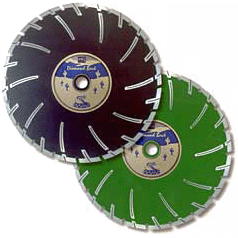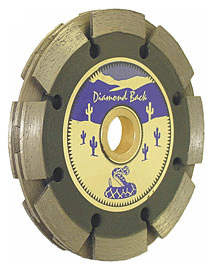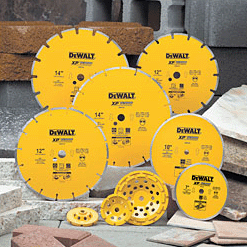Diamonds are a Mason's Best Friend
Types of Materials
 Brick manufacturing today follows fundamental procedures pioneered centuries ago; however, better knowledge of raw materials and their properties, plus better control of firing and improved kiln designs have resulted in a vastly superior product.
Brick manufacturing today follows fundamental procedures pioneered centuries ago; however, better knowledge of raw materials and their properties, plus better control of firing and improved kiln designs have resulted in a vastly superior product.
The manufacturing of brick is centered on the type of clay that is used. Clays occur in three forms: surface clays, fire clays and shales. Although they share similar chemical compositions, they differ in their physical characteristics. The properties of brick are affected by the composition of the raw materials used and manufacturing processes. Essentially brick is produced by: A) mixing ground clay with water, B) forming them into desired shapes, and C) then drying and firing them.
There are many different types of brick (building, facing, hollow, paving, ceramic glazed and thin brick), and different scales of hardness. Brick may also include different size, type and volume of aggregates to further strengthen the mix. The strength of a unit is used to determine its durability and "cutability." The compressive strength and absorption potential of brick are affected by properties of the clay, plus the method of manufacturing that includes degree of firing. Most bricks have strengths ranging from 3,000 pounds per square inch (psi) to over 20,000 psi.
On general appearance alone, it is difficult to differentiate a 3,000-psi brick from a 20,000-psi brick. However, there are obvious differences when one tries to cut these same two brick. That is when proper diamond blade selection comes into play.
Since masonry products exhibit characteristics that run from very hard (high psi) to very soft (or abrasive low psi), the selection of a diamond blade to properly match up to the material is essential. Unfortunately, one size does not necessarily fit all when it comes down to cutting with diamond blades.
 The technology of diamond blade manufacturing continues to improve. Time tested formulas of special synthetic diamond and powdered-metal mixtures (bond) ensure successful cutting potential ? if one chooses correctly!
The technology of diamond blade manufacturing continues to improve. Time tested formulas of special synthetic diamond and powdered-metal mixtures (bond) ensure successful cutting potential ? if one chooses correctly!
There exists an inverse relationship regarding the type of blade to choose versus the type of masonry material to cut. The rule of thumb is: for hard masonry materials, choose a soft bonded diamond blade; conversely, for a soft or abrasive masonry product, choose a hard bonded blade.
Why? A blade used for hard, non-abrasive masonry products must have a soft bond to ensure that it will effectively erode away and expose the embedded cutting diamonds. Conversely, a blade used for soft, abrasive materials must have a hard metal bond to resist this erosion process long enough for the exposed diamonds to be properly utilized. This process is often referred to as "controlled bond erosion."
To aid in your overall efforts, it is common for building supply houses and masonry material yards to offer information that define the hardness/abrasiveness of the masonry products they provide.
Types of Equipment
The types of sawing equipment that are used today to cut masonry products vary from the right-angle grinders and circular saws that we find in our tool boxes, to high-end, high-production masonry saws. Additionally, there are numerous masonry jobs covered by popular high-speed cut-off saws.
 Generally, the features regarding portable masonry sawing equipment have not changed much in the last several years. There have been, however, advancements to lessen the overall weight and/or size, while offering a greater variety of power plants to match up to the needs of the user. When faced with the challenges that surround masonry cutting, the saw you use to support your efforts must be chosen with reason and industry experience. Trade publications, such as Masonry, and data found on the Internet offer an ample opportunity to research the sawing equipment that is available and appropriate.
Generally, the features regarding portable masonry sawing equipment have not changed much in the last several years. There have been, however, advancements to lessen the overall weight and/or size, while offering a greater variety of power plants to match up to the needs of the user. When faced with the challenges that surround masonry cutting, the saw you use to support your efforts must be chosen with reason and industry experience. Trade publications, such as Masonry, and data found on the Internet offer an ample opportunity to research the sawing equipment that is available and appropriate.
The greatest change to cutting equipment surrounds the diamond blade itself. There have been numerous advances in diamond blade materials and manufacturing technology. More importantly for the consumer, because of the expanded breadth of diamond blade manufacturers/distributors/suppliers, pricing of diamond blades have become very attractive. However, like any dynamic tool, it is important to research the product you wish to use, and feel confident in the manufacturer that stands behind it.
Return on Investment
What user does not want a diamond blade that cuts everything, lasts forever, and costs little-to-nothing? Though in reality there is no such blade, there are ways to ensure that an optimum investment has been made.
Saw information, material make-up and job requirements you pass on to your supplier will better assist the process of selecting the right blade for the job. The efforts in matching blade type to material type will ultimately yield greater productivity, blade longevity, and lessen operator load. The end result is a faster, more professional job that ultimately saves you money.
Generally, there are not too many ways to cut corners when choosing diamond blades. Certainly, with the advancement of blade manufacturing, there are very reasonably priced products that advertise themselves to be "general purpose" cutting tools. However, if the issue is strictly price, there are a host of products that will give you what you paid for. But, when it comes to approaching your cutting requirements, by factoring in time, performance and professional results, the effort you spend researching your buying options may prove to be more than just a "dollars and cents" issue. In the end, only you can determine if you received a satisfactory return-on-your-investment.
Industry Trends
What we are witnessing for masonry cutting is a growing competitive industry that is yielding greater options for the end-user. There are many positive aspects for the consumer in this busy market. Diamond blade manufacturers are being challenged every year to offer better product at lower prices. Additionally, more equipment choices, greater range of diamond blades, and state-of-the-art manufacturing processes support the customer like never before. These enhancements make it that much easier for those with little diamond cutting experience to make better choices.
For experienced masons, the tools that support them continue to advance and become more affordable. For distribution, the growing number of large retail outlets have had a pronounced effect on the industry. The overwhelming options for product choices and possible suppliers put the end-user in the drivers seat, and manufactures and distributors are challenged at every turn to foster the loyalty of their customers.
Conclusion
Regardless of the product, we all wish to have the confidence that our hard-earned dollars have been spent wisely. As we have seen with the diamond blade selection process, it is more often the team effort between yourself and your supplier that facilitate the knowledge and advice that ensure sound tool selection. Together you have to weigh the variables and select the best-suited diamond blade for the job, application and material, which will ensure peak performance and maximum investment return.
About the Author
Bruce Coleman, Product Manager at Multiquip, Inc., has worked in the diamond blade industry since 1994.


















